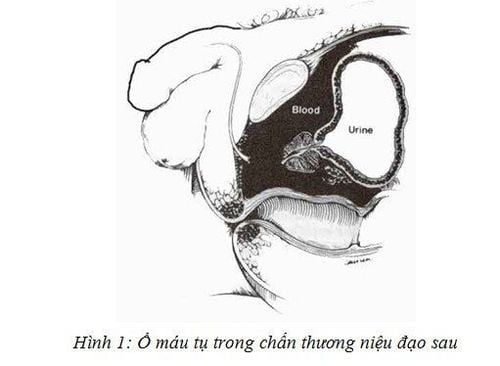This is an automatically translated article.
The article is professionally consulted by Master, Doctor Le Hong Chien - Radiologist - Department of Diagnostic Imaging and Nuclear Medicine - Vinmec Times City International Hospital. The doctor has many years of experience working in the field of diagnostic imaging and interventional radiology.In many cases, injury occurs to the bladder - urethra, urinary obstruction due to an enlarged prostate gland, ... making urine unable to be expelled on its own. Cases like these will be resolved with a suprapubic bladder drainage, also known as a drainage to bring urine out.
1. Indications for suprapubic bladder drainage
Cases of urethral stricture causing urinary retention; Unformed urethral trauma resulting in urinary retention; Prostate fibroids, or prostate cancer, that cause urinary retention; The phenomenon of narrowing of the bladder neck causes urinary retention; Injury to the bladder nerve or diseases that are congenital or cause urinary retention.2. Contraindications to mandatory bladder drainage
All cases of patients with severe systemic disease, unable to perform anesthesia or anesthesia to perform surgery are contraindicated for bladder drainage.3. Technique for performing bladder drainage on the pubic bone
3.1 Preparation
Things to prepare before bladder drainage:Procedure: 1 primary doctor, 2 assistant doctors, 1 equipment nurse, 1 peripheral nurse; Patient: Prepare like any other surgery: Check and evaluate the entire patient: Assess the general pathology, kidney function, whether the patient has anemia, the patient's coagulation factors is it normal; The genitals should be cleaned thoroughly, shaved off pubic hair, carefully disinfected below the navel; Patients must fast for at least 6 hours before surgery. The patient may be given an enema before performing a urinary drainage; The doctor must explain to the patient as well as the family about the indications, procedures and risks of possible complications during surgery. Equipment needed: Surgical instruments with automatic valves; Sonde petzer for drainage; Retzius drainage resin sonde; Slow indicator type 3.0, slow indicator type 1.0. Time to perform bladder drainage: about 30-60 minutes

3.2 Procedure for conducting urine drainage
Step 1: Patient is in supine position;Step 2: Administer anesthesia/anesthesia to the patient: local anesthesia or spinal anesthesia or anesthesia can be selected. This choice also depends on each patient's condition to have the most appropriate and optimal method;
Step 3: Perform the procedure:
Disinfect the surgical area from the breastbone to the pubic joint and 1/3 on the thigh to ensure sterility; Sterile towels; Make an incision about 5cm in the midline of the pubic bone; The fascia exposes the anterior surface of the bladder through the skin; Perform suture on the anterior wall of the bladder, opening the bladder about 3cm; Double check the bladder, prostate and 2 ureter openings; If there is a bladder stone, remove it, pump out the clot; Placing bladder drainage with Pezzer sonde, it should be noted that the placement of drainage is usually located in the dome of the bladder, the drainage tube tip should not be placed too close to the bladder neck to cause irritation or pain for the patient; Using the index of slow suturing the opening of the bladder; Check the level of circulation of the drainage tube, the tightness of the bladder suture carefully; Thoroughly check to prevent bleeding with certainty, use a catheter to drain the Retzius cavity; Using stitches to suture the bladder to the abdominal wall; Close the incision.
3.3 Monitoring the patient's postoperative condition and handling
Patient monitoring:General condition of the body: Vital signs, pulse, temperature, blood pressure, breathing rate Types of urine through the drain, color, volume, ... pay attention to avoid occlusion of the catheter. shut off the urinary tract; Drain the fluid to the space of Retzius; Is the incision condition swollen, pus-filled or not? Management of unwanted complications after surgery:
Complications from the effects of anesthetic drugs: depending on the severity of the patient's condition, there is an appropriate treatment direction. Peritoneal complications or intestinal perforation during surgery. open bladder surgery: if it's just a simple peritoneal tear, then suture is done, usually with slow suture. But in severe cases, it is necessary to contact a gastroenterologist to coordinate treatment; If after surgery, there is urine flow through the incision, drain Retzius: check to avoid obstruction of bladder drainage, change the dressing to avoid infection of the incision. Hemorrhage of catheter occlusion: Flush the bladder through the drain, continue rinsing the bladder if bleeding is still present, give antibiotics to the patient. To ensure safety, patients need to go to a reputable hospital to conduct examination, treatment and perform bladder drainage on the pubic bone. Currently, Vinmec International General Hospital is one of the leading prestigious hospitals in the country, trusted by a large number of patients for medical examination and treatment. Not only having a modern physical system and equipment, Vinmec is also a place to gather a team of experienced doctors and nurses who will bring the best treatment results to patients. In particular, with a space designed according to 5-star hotel standards, Vinmec ensures to bring the patient the most comfort, friendliness and peace of mind.
Please dial HOTLINE for more information or register for an appointment HERE. Download MyVinmec app to make appointments faster and to manage your bookings easily.














